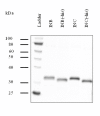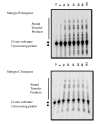Comparative biochemical analysis of HIV-1 subtype B and C integrase enzymes
- PMID: 19906306
- PMCID: PMC2779801
- DOI: 10.1186/1742-4690-6-103
Comparative biochemical analysis of HIV-1 subtype B and C integrase enzymes
Abstract
Background: Integrase inhibitors are currently being incorporated into highly active antiretroviral therapy (HAART). Due to high HIV variability, integrase inhibitor efficacy must be evaluated against a range of integrase enzymes from different subtypes.
Methods: This study compares the enzymatic activities of HIV-1 integrase from subtypes B and C as well as susceptibility to various integrase inhibitors in vitro. The catalytic activities of both enzymes were analyzed in regard to each of 3' processing and strand transfer activities both in the presence and absence of the integrase inhibitors raltegravir (RAL), elvitegravir (EVG), and MK-2048.
Results: Our results show that integrase function is similar with enzymes of either subtype and that the various integrase strand transfer inhibitors (INSTIs) that were employed possessed similar inhibitory activity against both enzymes.
Conclusion: This suggests that the use of integrase inhibitors against HIV-1 subtype C will result in comparable outcomes to those obtained against subtype B infections.
Figures













References
-
- Grinsztejn B, Nguyen BY, Katlama C, Gatell JM, Lazzarin A, Vittecoq D, Gonzalez CJ, Chen J, Harvey CM, Isaacs RD. Safety and efficacy of the HIV-1 integrase inhibitor raltegravir (MK-0518) in treatment-experienced patients with multidrug-resistant virus: a phase II randomised controlled trial. Lancet. 2007;369:1261–1269. doi: 10.1016/S0140-6736(07)60597-2. - DOI - PubMed
-
- Shimura K, Kodama E, Sakagami Y, Matsuzaki Y, Watanabe W, Yamataka K, Watanabe Y, Ohata Y, Doi S, Sato M, Kano M, Ikeda S, Matsuoka M. Broad Antiretroviral Activity and Resistance Profile of the Novel Human Immunodeficiency Virus Integrase Inhibitor Elvitegravir (JTK-303/GS-9137) J Virol. 2008;82:764–774. doi: 10.1128/JVI.01534-07. - DOI - PMC - PubMed
-
- Cooper DA, Steigbigel RT, Gatell JM, Rockstroh JK, Katlama C, Yeni P, Lazzarin A, Clotet B, Kumar PN, Eron JE, Schechter M, Markowitz M, Loutfy MR, Lennox JL, Zhao J, Chen J, Ryan DM, Rhodes RR, Killar JA, Gilde LR, Strohmaier KM, Meibohm AR, Miller MD, Hazuda DJ, Nessly ML, DiNubile MJ, Isaacs RD, Teppler H, Nguyen BY. BENCHMRK Study Teams. Subgroup and Resistance Analyses of Raltegravir for Resistant HIV-1 Infection. N Engl J Med. 2008;359:355–365. doi: 10.1056/NEJMoa0708978. - DOI - PubMed
Publication types
MeSH terms
Substances
Grants and funding
LinkOut - more resources
Full Text Sources

